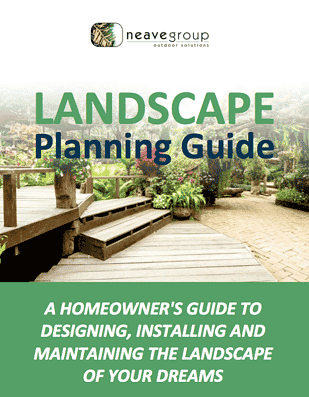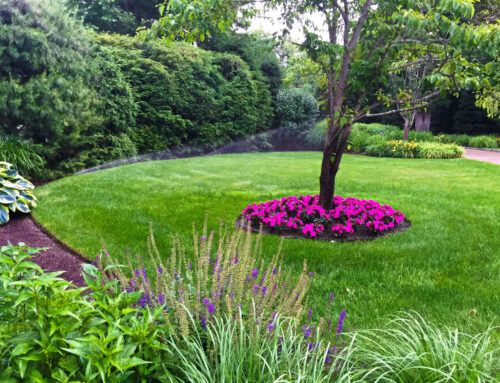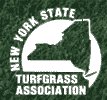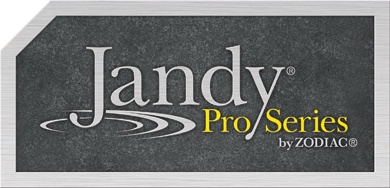Landscape plants around your home’s foundation can speak volumes. Are the shrubs so overgrown they block your windows? Are the plants so sparse your neighbors can see your not-so-lovely foundation?
The right mix of foundation plants can make or break a home’s curb appeal. The real challenge for homeowners can be deciding exactly what to plant – and where to plant it.
Why Are Foundation Plantings Important?
Foundation plantings are the plant’s closest to your home. Their job? To enhance your home, soften its hard edges, make it more welcoming and tie it to the surrounding landscape.
Unfortunately, too many homeowners leave this important job to a sad row of scraggly evergreens. They just can’t pull it off.
The good news? Here in New York and Connecticut, there are great options abound for pretty, house foundation plants. But don’t completely ditch the evergreens — they offer great year-round interest. You’ll want to mix in deciduous shrubs, ornamental grasses and perennials, too.
Neave Group’s Favorite Foundation Plants for Landscaping
Let’s take a look at eight of the best foundation plants that are perfect for your landscape. Here are our top choices:
American Holly
Evergreen foundation plants are great for softening the corner of a house or to flank an entrance. American holly scores points for being a native plant, as well as looking pretty with its glossy green leaves and bright red berries. Because American holly is native here, birds love the berries and also use it for shelter. Plant this, then watch for bluebirds, northern cardinals, woodpeckers and cedar waxwings to come around.
Boxwood
Boxwood is a foundation planting staple, boxwood is great for creating formal accents or hedging. ‘Newport Blue’ is an elegant shrub with frosty blue new growth. Korean boxwood is faster growing than typical English varieties, stays compact and low growing, reaching about 2 feet tall.
Threadleaf False Cypress ‘Golden Mop’
This compact yellow foliage plant offers color and year-round interest. Its yellow feathery foliage looks great against deep green shrubs and provides great texture. Bonus: it’s deer-resistant.
Knock Out Roses
If you love roses, why not showcase them out front? Knock Out offers compact pink and red roses that flower all summer and resist pests and diseases. This type of shade foundation plant can be maintained as nicely shaped shrubs 3 to 4 feet tall. Roses prefer sun but do well in partial shade.
Summersweet
Summersweet is an easy-care native with oval leaves and fluffy spikes of white flowers in mid to late summer. Chose the ‘Sixteen Candles’ variety and expect butterflies and hummingbirds to visit. Bonus: yellow-orange foliage in the fall.
‘Autumn Joy’ Sedum
‘Autumn Joy’ Sedum is one of the best four-season perennials. It’s beautiful in full bloom, with large clusters of tiny rose-colored flowers in late summer to early fall. Leave the faded flower heads for winter interest. Cut it back in the spring, and fleshy green leaves are quick to pop out.
Catmint
A great bloomer from summer through fall, catmint offers spires of fuzzy gray leaves with tiny purple-blue flowers. Catmint looks a lot like lavender, but it’s not so finicky. If you want a big stunner, choose the ‘Six Hills Giant’ variety, which grows 3 to 4 feet tall. ‘Walker’s Low’ is a medium-size flower that grows 18-inches tall and works well massed.
‘Karl Foerster’ Grass
‘Karl Foerster’ is a great grass that features arching, glossy, dark green foliage 3 to 5 feet tall. In June, look for pinkish-bronze flower heads that gradually change to golden tan. Pretty year round.
Tips For Successful Foundation Planting Plans
A successful foundation planting starts with choosing the right plants in the right proportion. Consider these tips for your landscape planting plan:
The Right Mix of Evergreens
You’ll want small evergreen foundation plants to provide a good structural background, deciduous and flowering shrubs to add texture, and perennials of assorted heights to offer color.
Maximize Your Flower Beds
Many foundation plants are too narrow, with a single row of skimpy shrubs that doesn’t extend far enough out into the yard. Consider enlarging your flower bed and adding more plants in front.
Landscape Layering
Layer plants back to front from tallest to shortest. Check the growing height for each type, and make sure the plants in front won’t grow taller than the ones behind them.
One Plant Size Does Not Fit All
Choose the right size plants for the job. Have you ever seen a home with windows shrouded by too-tall shrubs? Check the plant’s size at maturity before you plant. Look for dwarf varieties for under windows and other tight spots – that will minimize pruning.
Neave Landscaping has been creating beautiful landscapes for more than 40 years. Our experts have a great handle on all kinds of growing things, including finding the best foundation plants for your landscape.
Our landscape management team of professionals will visit your property and discuss your many options, including grasses, perennials, shrubs, and trees. Leave the planting to our residential landscapers, knowing your home will look inviting and expertly landscaped.
If you’re in the Hudson Valley, call us at (845) 463-0592. If you’re in Westchester County, call (914) 271-7996; from Connecticut, dial (203) 212-4800. Or, fill out our contact form and we’ll contact you about setting up your free consultation.
























